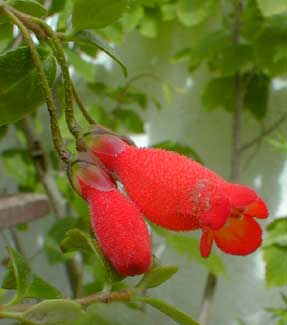
"Little Bottles"
Mitraria coccinea
"Love! thy love pours down on mine
As the sunlight on the vine."
-George Meredith
(1828-1909)
(1828-1909)
Mitraria coccinea is a loosely limbed evergreen shrub with a scrambling & climbing tendency, occasionally epiphytic (living in trees without soil), & yet just as capable of developing thick deep roots. It can be pruned & trained as it grows in an enclosed shade garden to become a large interweaving mounding shrub.
Somewhat brittle-limbed, they are so easily rooted from cuttings that broken limbs have been known to root themselves right where they fall. Growth is swift & vigorous but it can look thin & lanky without regular training with pruning shears in hand.
It's one of the more floriferous shade shrubs, producing large numbers of tubular urn-shaped two-inch-long intensely orange-red flowers from May to July, potentially reflowering up to September. It needs a sheltered partial to bright shade location away from winter winds & especially protected from harsh sun of high summer, as Mitraria is not terribly heat-hardy.
It is not so commonly gardened in North America as to have acquired a common name more widely used than its genus name, but some have assumed its genus name alludes to the tubular flowers looking to some like little hats of a bishop, hence the occasional common names Chilean Mitre Flower or Scarlet Mitre Pod.
 This seems a great stretch to me, as it is much more a tubular bladder than a hat. Within its Patagonian range it is much more evocatively known as Botellita, or Little Bottles.
This seems a great stretch to me, as it is much more a tubular bladder than a hat. Within its Patagonian range it is much more evocatively known as Botellita, or Little Bottles.Further, the genus name was never intended as a reference to a bishop's mitre, but is in honor of Bartoleme Mitre (1821-1906), a 19th Century author who served as president of Argentina from 1862 to 1868. His portrait is reproduced with this article.
It is sometimes described as not frost-hardy & preferrable in containers that can be brought to cover in winters, but Heronswood reports that it has weathered winters down to ten degrees just fine. Give it persistent moisture in well-draining soil in a cool location & it should do just fine.
Since it has its limitations for winter temperatures, in some areas it would be advisable to use it as a wall-shrub so that it would have some residual heat from the house when temperatures fall into the teens.
It is easily espaliered & does well with espaliered Camellia sasanqua though not sharing a scrambling camellea's drought hardiness. More than the sasanqua it is sometimes able to attach itself to a very rough stone wall or to rough bark of a large tree, but usually it needs espalier training & tying to be a successful wall shrub.
Originating from temperate rainforests & moderately high elevations of mountains in Chile, Mitraria is exceedingly hardy for Puget Sound condition (USDA zones 7 & 8), but only half-hardy elsewhere. Ours came from Heronswood Nursery which has offered both the so-called "Lake Puye form" or "Lake Puyehue form," & others from cuttings taken from the wild, which Heronswood assessed as indistinguishable.